Aude Oliva
MIT
ConMe: Rethinking Evaluation of Compositional Reasoning for Modern VLMs
Jun 12, 2024



Abstract:Compositional Reasoning (CR) entails grasping the significance of attributes, relations, and word order. Recent Vision-Language Models (VLMs), comprising a visual encoder and a Large Language Model (LLM) decoder, have demonstrated remarkable proficiency in such reasoning tasks. This prompts a crucial question: have VLMs effectively tackled the CR challenge? We conjecture that existing CR benchmarks may not adequately push the boundaries of modern VLMs due to the reliance on an LLM-only negative text generation pipeline. Consequently, the negatives produced either appear as outliers from the natural language distribution learned by VLMs' LLM decoders or as improbable within the corresponding image context. To address these limitations, we introduce ConMe -- a compositional reasoning benchmark and a novel data generation pipeline leveraging VLMs to produce `hard CR Q&A'. Through a new concept of VLMs conversing with each other to collaboratively expose their weaknesses, our pipeline autonomously generates, evaluates, and selects challenging compositional reasoning questions, establishing a robust CR benchmark, also subsequently validated manually. Our benchmark provokes a noteworthy, up to 33%, decrease in CR performance compared to preceding benchmarks, reinstating the CR challenge even for state-of-the-art VLMs.
$\textit{Trans-LoRA}$: towards data-free Transferable Parameter Efficient Finetuning
May 27, 2024



Abstract:Low-rank adapters (LoRA) and their variants are popular parameter-efficient fine-tuning (PEFT) techniques that closely match full model fine-tune performance while requiring only a small number of additional parameters. These additional LoRA parameters are specific to the base model being adapted. When the base model needs to be deprecated and replaced with a new one, all the associated LoRA modules need to be re-trained. Such re-training requires access to the data used to train the LoRA for the original base model. This is especially problematic for commercial cloud applications where the LoRA modules and the base models are hosted by service providers who may not be allowed to host proprietary client task data. To address this challenge, we propose $\textit{Trans-LoRA}$ -- a novel method for lossless, nearly data-free transfer of LoRAs across base models. Our approach relies on synthetic data to transfer LoRA modules. Using large language models, we design a synthetic data generator to approximate the data-generating process of the $\textit{observed}$ task data subset. Training on the resulting synthetic dataset transfers LoRA modules to new models. We show the effectiveness of our approach using both LLama and Gemma model families. Our approach achieves lossless (mostly improved) LoRA transfer between models within and across different base model families, and even between different PEFT methods, on a wide variety of tasks.
Dense Training, Sparse Inference: Rethinking Training of Mixture-of-Experts Language Models
Apr 08, 2024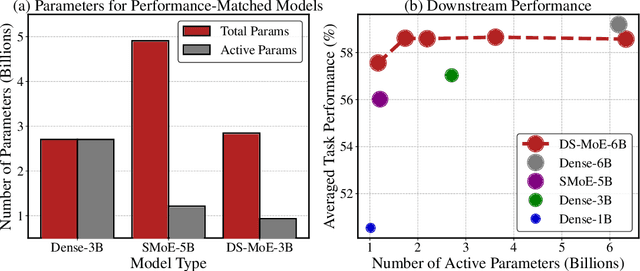
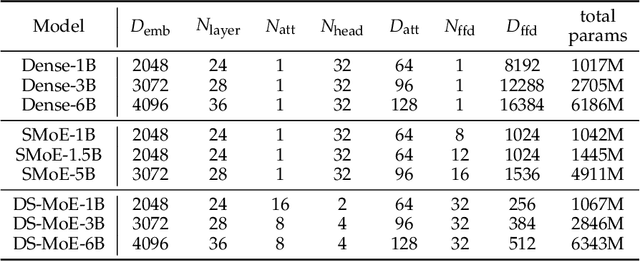


Abstract:Mixture-of-Experts (MoE) language models can reduce computational costs by 2-4$\times$ compared to dense models without sacrificing performance, making them more efficient in computation-bounded scenarios. However, MoE models generally require 2-4$\times$ times more parameters to achieve comparable performance to a dense model, which incurs larger GPU memory requirements and makes MoE models less efficient in I/O-bounded scenarios like autoregressive generation. In this work, we propose a hybrid dense training and sparse inference framework for MoE models (DS-MoE) which achieves strong computation and parameter efficiency by employing dense computation across all experts during training and sparse computation during inference. Our experiments on training LLMs demonstrate that our DS-MoE models are more parameter-efficient than standard sparse MoEs and are on par with dense models in terms of total parameter size and performance while being computationally cheaper (activating 30-40% of the model's parameters). Performance tests using vLLM show that our DS-MoE-6B model runs up to $1.86\times$ faster than similar dense models like Mistral-7B, and between $1.50\times$ and $1.71\times$ faster than comparable MoEs, such as DeepSeekMoE-16B and Qwen1.5-MoE-A2.7B.
Learning Human Action Recognition Representations Without Real Humans
Nov 10, 2023



Abstract:Pre-training on massive video datasets has become essential to achieve high action recognition performance on smaller downstream datasets. However, most large-scale video datasets contain images of people and hence are accompanied with issues related to privacy, ethics, and data protection, often preventing them from being publicly shared for reproducible research. Existing work has attempted to alleviate these problems by blurring faces, downsampling videos, or training on synthetic data. On the other hand, analysis on the transferability of privacy-preserving pre-trained models to downstream tasks has been limited. In this work, we study this problem by first asking the question: can we pre-train models for human action recognition with data that does not include real humans? To this end, we present, for the first time, a benchmark that leverages real-world videos with humans removed and synthetic data containing virtual humans to pre-train a model. We then evaluate the transferability of the representation learned on this data to a diverse set of downstream action recognition benchmarks. Furthermore, we propose a novel pre-training strategy, called Privacy-Preserving MAE-Align, to effectively combine synthetic data and human-removed real data. Our approach outperforms previous baselines by up to 5% and closes the performance gap between human and no-human action recognition representations on downstream tasks, for both linear probing and fine-tuning. Our benchmark, code, and models are available at https://github.com/howardzh01/PPMA .
LangNav: Language as a Perceptual Representation for Navigation
Oct 11, 2023



Abstract:We explore the use of language as a perceptual representation for vision-and-language navigation. Our approach uses off-the-shelf vision systems (for image captioning and object detection) to convert an agent's egocentric panoramic view at each time step into natural language descriptions. We then finetune a pretrained language model to select an action, based on the current view and the trajectory history, that would best fulfill the navigation instructions. In contrast to the standard setup which adapts a pretrained language model to work directly with continuous visual features from pretrained vision models, our approach instead uses (discrete) language as the perceptual representation. We explore two use cases of our language-based navigation (LangNav) approach on the R2R vision-and-language navigation benchmark: generating synthetic trajectories from a prompted large language model (GPT-4) with which to finetune a smaller language model; and sim-to-real transfer where we transfer a policy learned on a simulated environment (ALFRED) to a real-world environment (R2R). Our approach is found to improve upon strong baselines that rely on visual features in settings where only a few gold trajectories (10-100) are available, demonstrating the potential of using language as a perceptual representation for navigation tasks.
Going Beyond Nouns With Vision & Language Models Using Synthetic Data
Mar 30, 2023



Abstract:Large-scale pre-trained Vision & Language (VL) models have shown remarkable performance in many applications, enabling replacing a fixed set of supported classes with zero-shot open vocabulary reasoning over (almost arbitrary) natural language prompts. However, recent works have uncovered a fundamental weakness of these models. For example, their difficulty to understand Visual Language Concepts (VLC) that go 'beyond nouns' such as the meaning of non-object words (e.g., attributes, actions, relations, states, etc.), or difficulty in performing compositional reasoning such as understanding the significance of the order of the words in a sentence. In this work, we investigate to which extent purely synthetic data could be leveraged to teach these models to overcome such shortcomings without compromising their zero-shot capabilities. We contribute Synthetic Visual Concepts (SyViC) - a million-scale synthetic dataset and data generation codebase allowing to generate additional suitable data to improve VLC understanding and compositional reasoning of VL models. Additionally, we propose a general VL finetuning strategy for effectively leveraging SyViC towards achieving these improvements. Our extensive experiments and ablations on VL-Checklist, Winoground, and ARO benchmarks demonstrate that it is possible to adapt strong pre-trained VL models with synthetic data significantly enhancing their VLC understanding (e.g. by 9.9% on ARO and 4.3% on VL-Checklist) with under 1% drop in their zero-shot accuracy.
Deepfake Caricatures: Amplifying attention to artifacts increases deepfake detection by humans and machines
Jun 02, 2022
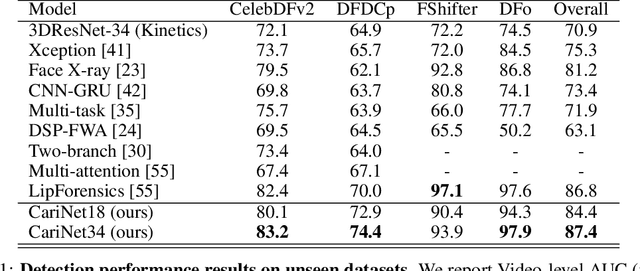

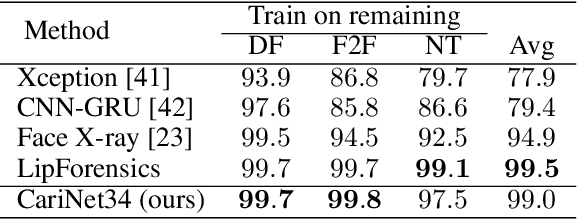
Abstract:Deepfakes pose a serious threat to our digital society by fueling the spread of misinformation. It is essential to develop techniques that both detect them, and effectively alert the human user to their presence. Here, we introduce a novel deepfake detection framework that meets both of these needs. Our approach learns to generate attention maps of video artifacts, semi-supervised on human annotations. These maps make two contributions. First, they improve the accuracy and generalizability of a deepfake classifier, demonstrated across several deepfake detection datasets. Second, they allow us to generate an intuitive signal for the human user, in the form of "Deepfake Caricatures": transformations of the original deepfake video where attended artifacts are exacerbated to improve human recognition. Our approach, based on a mixture of human and artificial supervision, aims to further the development of countermeasures against fake visual content, and grants humans the ability to make their own judgment when presented with dubious visual media.
Ego4D: Around the World in 3,000 Hours of Egocentric Video
Oct 13, 2021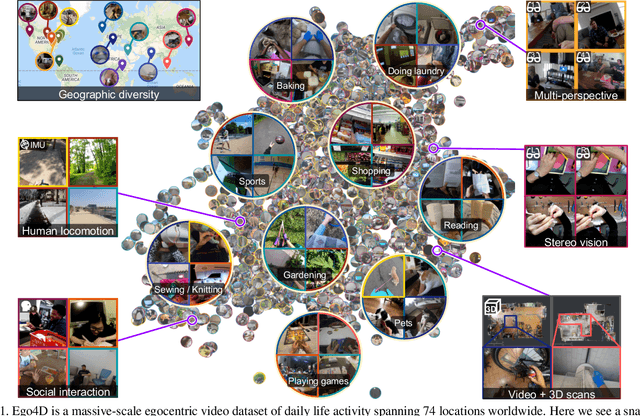
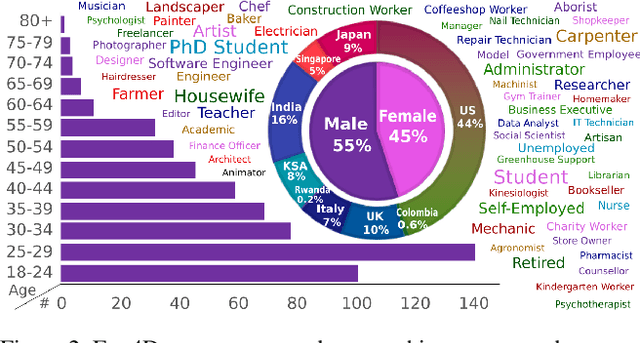

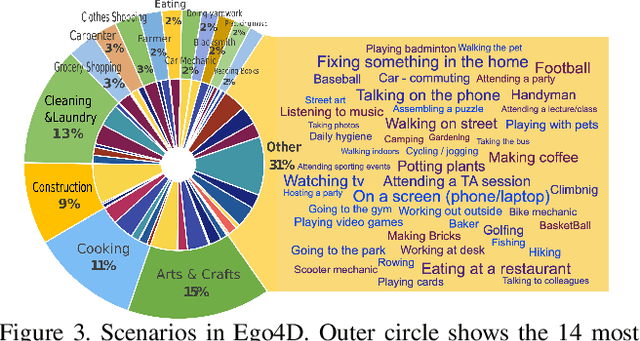
Abstract:We introduce Ego4D, a massive-scale egocentric video dataset and benchmark suite. It offers 3,025 hours of daily-life activity video spanning hundreds of scenarios (household, outdoor, workplace, leisure, etc.) captured by 855 unique camera wearers from 74 worldwide locations and 9 different countries. The approach to collection is designed to uphold rigorous privacy and ethics standards with consenting participants and robust de-identification procedures where relevant. Ego4D dramatically expands the volume of diverse egocentric video footage publicly available to the research community. Portions of the video are accompanied by audio, 3D meshes of the environment, eye gaze, stereo, and/or synchronized videos from multiple egocentric cameras at the same event. Furthermore, we present a host of new benchmark challenges centered around understanding the first-person visual experience in the past (querying an episodic memory), present (analyzing hand-object manipulation, audio-visual conversation, and social interactions), and future (forecasting activities). By publicly sharing this massive annotated dataset and benchmark suite, we aim to push the frontier of first-person perception. Project page: https://ego4d-data.org/
Dynamic Network Quantization for Efficient Video Inference
Aug 23, 2021
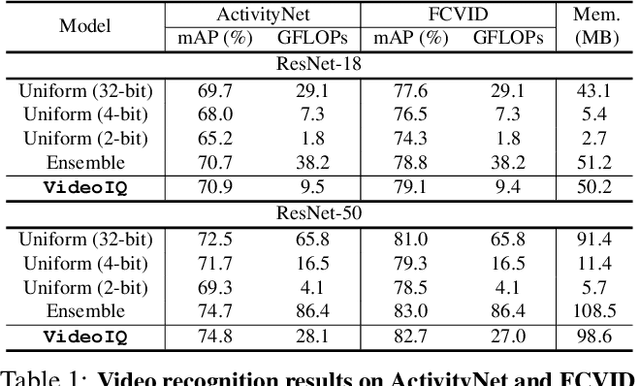

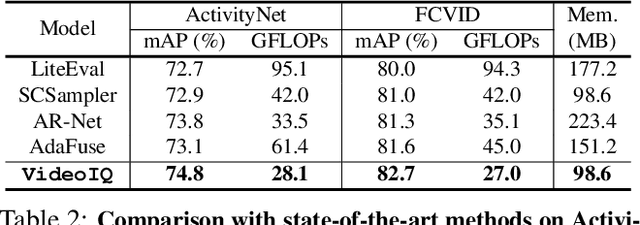
Abstract:Deep convolutional networks have recently achieved great success in video recognition, yet their practical realization remains a challenge due to the large amount of computational resources required to achieve robust recognition. Motivated by the effectiveness of quantization for boosting efficiency, in this paper, we propose a dynamic network quantization framework, that selects optimal precision for each frame conditioned on the input for efficient video recognition. Specifically, given a video clip, we train a very lightweight network in parallel with the recognition network, to produce a dynamic policy indicating which numerical precision to be used per frame in recognizing videos. We train both networks effectively using standard backpropagation with a loss to achieve both competitive performance and resource efficiency required for video recognition. Extensive experiments on four challenging diverse benchmark datasets demonstrate that our proposed approach provides significant savings in computation and memory usage while outperforming the existing state-of-the-art methods.
IA-RED$^2$: Interpretability-Aware Redundancy Reduction for Vision Transformers
Jun 23, 2021

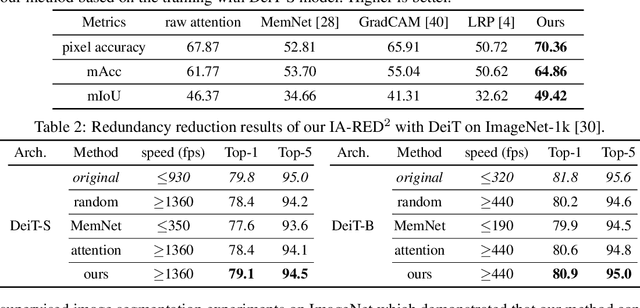

Abstract:The self-attention-based model, transformer, is recently becoming the leading backbone in the field of computer vision. In spite of the impressive success made by transformers in a variety of vision tasks, it still suffers from heavy computation and intensive memory cost. To address this limitation, this paper presents an Interpretability-Aware REDundancy REDuction framework (IA-RED$^2$). We start by observing a large amount of redundant computation, mainly spent on uncorrelated input patches, and then introduce an interpretable module to dynamically and gracefully drop these redundant patches. This novel framework is then extended to a hierarchical structure, where uncorrelated tokens at different stages are gradually removed, resulting in a considerable shrinkage of computational cost. We include extensive experiments on both image and video tasks, where our method could deliver up to 1.4X speed-up for state-of-the-art models like DeiT and TimeSformer, by only sacrificing less than 0.7% accuracy. More importantly, contrary to other acceleration approaches, our method is inherently interpretable with substantial visual evidence, making vision transformer closer to a more human-understandable architecture while being lighter. We demonstrate that the interpretability that naturally emerged in our framework can outperform the raw attention learned by the original visual transformer, as well as those generated by off-the-shelf interpretation methods, with both qualitative and quantitative results. Project Page: http://people.csail.mit.edu/bpan/ia-red/.
 Add to Chrome
Add to Chrome Add to Firefox
Add to Firefox Add to Edge
Add to Edge